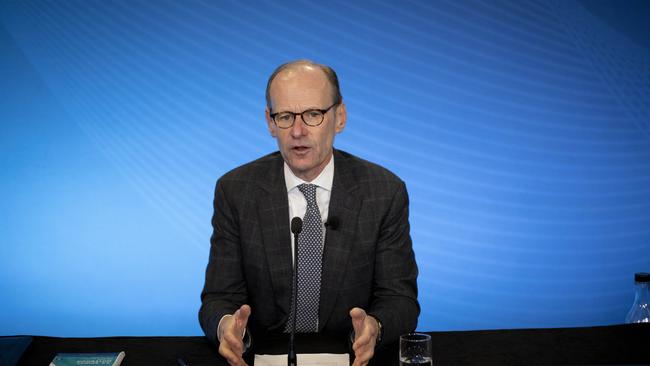ANZ calls out low mortgage returns, financial system safety focus for poor lending access
ANZ chief executive Shayne Elliott has blamed wafer-thin returns on home loans for the bank’s decision to provide more favourable mortgage terms to wealthy customers.
Business
Don't miss out on the headlines from Business. Followed categories will be added to My News.
ANZ chief executive Shayne Elliott has blamed wafer-thin returns on home loans for the bank’s decision to provide more favourable mortgage terms to wealthy customers.
Mr Elliott’s comments came at ANZ’s seventh Environmental, Social and Governance (ESG) briefing for analysts and investors, where he also cautioned that mortgage hardship levels were set to rise as inflation levels remained high and cost of living pressures persisted. Fitch Ratings’ latest data showed 30-day mortgage arrears across the sector’s securitised loans rose to a five-year high of 1.3 per cent in the March quarter.
Asked about ANZ’s decision to provide more favourable loan terms to wealthy customers in 145 postcodes, but not introduce measures for first home buyers, Mr Elliott said the bank was constrained by returns.
“The returns on home loans aren’t what they used to be so when the average return now on home lending is … above, but barely above the cost of capital, your options are limited,” he said.
“That is part of the reason the industry, not just us … is skewing towards the wealthy.
“We constantly have to be looking for policy settings … products et cetera that can make those sorts of things affordable and encourage first home buyers.
“I’m not going to profess that we have all the answers, we don’t. It’s a very, very complex issue … we get it, it’s our responsibility to lean in and be part of the broader discussion.”
ANZ’s new policy, rolled out this month, allows wealthy customers in designated postcodes to borrow up to 95 per cent of a property’s value without mortgage insurance.
Typically, when a borrower takes out a mortgage with less than a 20 per cent deposit banks require lenders’ mortgage insurance, which is paid for by borrowers.
Regarding debate on the nation’s housing shortage and affordability issues, Mr Elliott said ANZ was focusing efforts on measures to boost housing supply and support developers.
“We’re supporting an increase in the supply of social and affordable housing by investing in emerging housing markets, such as specialist disability accommodation, land lease housing and build to rent.”
As at March 31, ANZ had funded or facilitated about $5.7bn since 2018 toward its $10bn investment target for affordable, accessible and sustainable housing. The target runs through until the end of 2030.
Mr Elliott on Thursday also hit back at the Australian Prudential Regulation Authority’s criticism of banks, after chairman John Lonsdale said there was ample scope for lenders to lift their risk appetites.

Mr Elliott and other bank bosses have argued the regulatory environment makes the lending climate too restrictive, with ANZ labelling APRA’s home loan lending buffers as too high.
“As a society we have voted, either consciously or not, for safety,” Mr Elliott said at the briefing, noting measures to keep the banking system safe came at a cost.
“(This) means middle Australia gets locked out … we can sit there and say it’s because prices are high, but it’s also because they do have less access to credit than they would have had in the past.”
JPMorgan analyst Andrew Triggs noted while he didn’t expect the banking sector’s structural issues would resolve overnight, “competitive headwinds are moderating and replicating portfolios are providing benefits”.
“The industry is arguably reaching a floor, as two of the four majors (ANZ/Westpac) now have ROEs (return-on-equities) close to the cost of capital,” he said in a research note.
With increasing expectations among economists that the Reserve Bank of Australia may raise official rates to temper inflation in coming months, the big banks are also closely monitoring loan arrears and hardship levels.
Mr Elliott stressed, with inflation remaining “stubbornly above” the RBA’s target band, he expected ANZ’s hardship levels would continue to climb.
“While these numbers are still low in historical terms, we expect they will continue to rise given the external environment, and we are working hard to help people who are struggling,” he said.
“We are also trying to connect with customers in difficulty sooner, including by using data analytics and modelling to proactively identify those facing hardship triggers, such as reduced income or negative cash flow.”
Over the last year, ANZ has seen an increase in home loan customers in hardship to about three in 1000 people. The number for small businesses sits at about two in 1000.
The bank said hardship was being primarily caused by reduced income, increased expenses, medical reasons, unemployment and relationship separations.
ANZ noted FoodBank was delivering roughly 65,000 meals every day in Melbourne and some Australians were skipping meals to keep up with expenses.
Looking ahead, Mr Elliott said ANZ was mindful of a range of ESG areas including executing its “hardship action plan”, addressing ethical questions around artificial intelligence, boosting the bank’s governance, diversity and inclusion and supporting a transition to net zero.
“We take ESG as seriously as our financial results,” he added.
Mr Elliott said ANZ was talking to its biggest emitting customers but noted it would be “pretty rare” for the bank to cease services to large customers, unless they didn’t have any credible decarbonisation plans.
ANZ’s briefing also showed it is establishing a bank strategy for first nation’s people in Australia led by Shelley Cable.
She said, subject to consultation, ANZ’s strategy would focus on financial wellbeing, banking the first nation’s economy and improving ANZ’s “cultural capability”.
“This sector contributed around $16bn to Australia’s GDP (gross domestic product) in 2022.”
More Coverage
Originally published as ANZ calls out low mortgage returns, financial system safety focus for poor lending access





